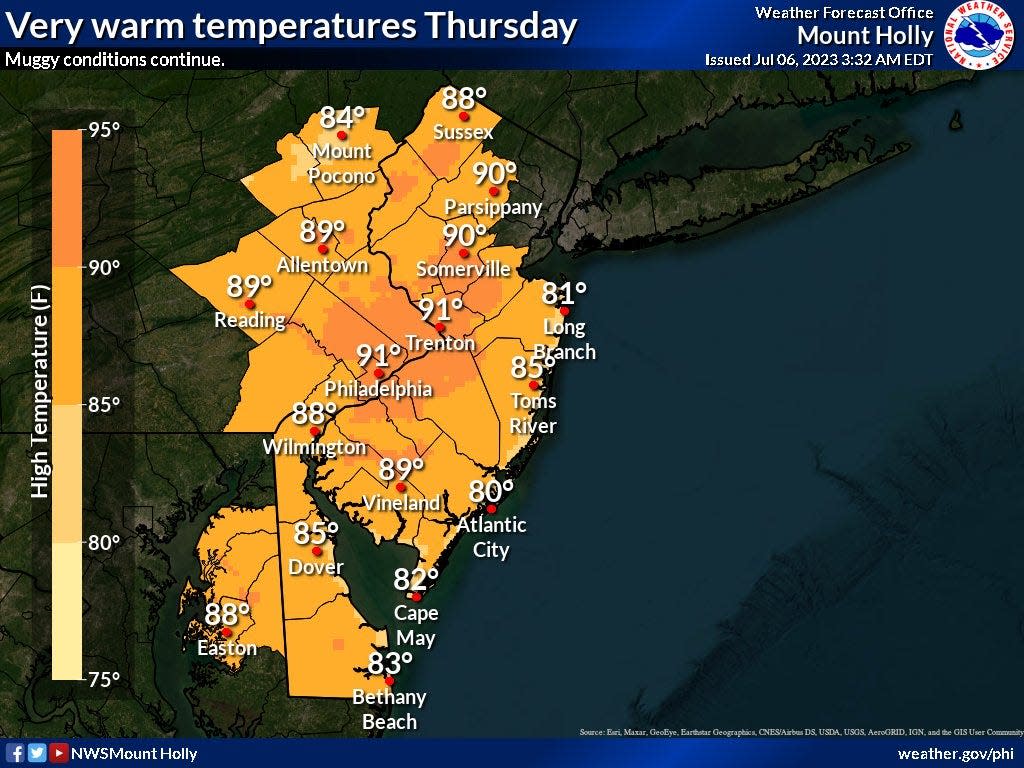High temperatures and humidity to impact Bucks County. What to expect and how to stay cool

Call it Netflix's most popular dating show, because Bucks County may be too hot to handle.
Temperatures will reach the 90s Thursday throughout the area in what National Weather Service meteorologist Ray Martin described as typical summer weather following a cooler-than-usual June.
"Actually, the more unusual part about this year is that we haven't really had much summer up until recently," Martin said. "And a lot of people are not acclimated to what we typically see in July."
Thursday is the first time in 2023 that Bucks County has experienced consecutive days with temperatures in the 90s, but the week's heat does not constitute a heat wave yet, which would require three consecutive 90-degree days.
"We haven't had a heat wave yet, which, you know, is a little unusual this late," Martin said. "It's not unprecedented or anything."
Martin said the East Coast is experiencing a Bermuda High, a common summer weather pattern which brings air up to the Northeast from the Gulf of Mexico and Southeast, resulting in warm temperatures and high humidity.
After Thursday's heat, a weak front will likely nudge temperatures in Bucks County down Friday and Saturday, bringing with it an increased chance of showers and thunderstorms. Another front is forecasted to move through the area Sunday, bringing what Martin said will be the week's highest chances of rain and thunderstorms.
What is high humidity?
In order to conceptualize high humidity, you have to understand relative humidity.
Relative humidity, like the percentage you may see reported on your weather app, correlates to the amount of moisture or water vapor in the air, compared to how much of that moisture the air could hold. Warm air can hold more water vapor than cold air.
And while it may be easy to look at the day's humidity forecast before you step outside, the NWS actually advises that you pay attention to the dew point to gauge the day's feel.
The dew point is the temperature the air needs to be cooled to in order to reach a relative humidity of 100%. What's really important to know is that the higher the dew point is on any given day, the more moisture there is in the air.
From the NWS, here is a quick way to tell what the comfort levels of humidity will be this summer based on the dew point.
Less than or equal to 55 degrees brings dry and comfortable conditions. Anywhere between 55 and 65 degrees will cause "sticky" weather and muggier evenings, while dew points greater than or equal to 65 degrees indicate lots of moisture in the air, making the conditions "oppressive."
How to stay safe in the heat
According to the National Weather Service, heat poses as one of the most dangerous weather-related killers in the United States. While anyone can be vulnerable to heat, the weather service warns that young children and infants, older adults, people with chronic medical conditions and pregnant women all face an increased health risk with high temperatures.
The weather service advises people to never leave a child, disabled person or pet in the car, which can be dangerous even in winter. In 2022 alone, 33 children in the U.S. died in hot cars. It is also possible that children enter a hot car on their own, so the weather service recommends that families with toddlers lock their driveway car's doors to avoid a potential tragedy.
With high heat, it is important to check on people you know who may be vulnerable to the weather, especially if they don't have air conditioning.
According to Heat.gov, the signs of heat exhaustion are dizziness, heavy sweating, nausea, strong thirst and muscle weakness. In order to reduce the risk of a heat stroke, people suffering from these symptoms should move to a cooler area, loosen their clothing, sip cool water an seek medical attention if their symptoms don't improve.
Dealing with a heat stroke, however, is an emergency situation. A victim experiencing a heat stroke may be confused, dizzy, or even fall unconscious, and requires immediate emergency treatment in order to prevent death or permanent disability.
In order to prevent any heat-related injuries, Heat.gov advises people to stay cool, hydrated and informed.
This article originally appeared on Bucks County Courier Times: How to stay cool as temperatures and humidity rise in Bucks County

